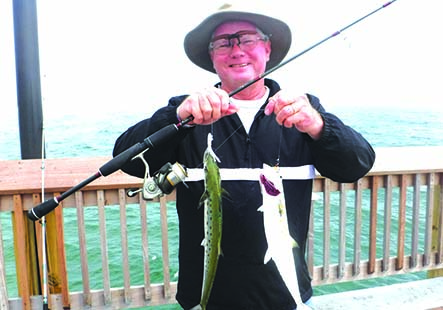Pier & Shore Fishing Outlook
Pier & Shore Fishing Outlook
By David “The Pierpounder” Thornton
Typical late fall type weather is forecast to continue through this upcoming fortnight. We can certainly expect some more chilly mornings after each frontal passage. Followed by a day or two of milder air temps with onshore winds and building seas before the next front blows through.
A La Nina pattern is expected to continue into the winter, which usually means it will be a bit milder and drier than average. But that should bode well for from shore anglers as the Gulf waters will continue to slowly cool due to the incursions of cold air and shorter length of days.
Frost, or even the first brief freeze of the season becomes a distinct possibility now.
Catches of smallish whiting (Gulf and Northern kingfish 8 to 12 inches long) continue to be the mainstay of surf and pier fishing success. Along with Southern kingfish (locally called ground mullet) and Atlantic croakers. But these croakers are spawning, so they tend to be be a little longer and heavier. Interjected among assorted panfish are occasional pompano, oversized redfish or black drum, out-of-season flounder, and the ever possible stingrays and catfish (hardheads and gafftops). Ugh! LOL
The tide level will be lowest during the late morning to midday hours, followed by an incoming tide in the afternoon. This give anglers two fish feeding windows of opportunity to find a good spot for catching fish.
But the middle of the day can be productive at times too, especially for sheepshead from the Gulf State Park Pier, and seawall or jetties at Perdido Pass.
It seems these striped bait stealers are not usually early risers. In fact they tend to feed better when the sun is highest or the water a little warmer with the afternoon incoming tide.
Most sheepshead are caught while they are most active, between the hours of 9 a.m. and 3 p.m. The deeper Gulf waters should only gradually cool through the upper 60s, while the shallower waters in the bays cool faster in the wake of strong cold fronts, from the middle to lower 60s. Beach anglers can expect the water temperature in the surf zone to be somewhere in between those two extremes, depending on the tide phase and meteorological conditions of the day.
Water temperature, salinity and clarity, along with wave heights, wind speed and direction are critical factors to determine when the more commonly targeted species of the surf zone will be feeding. Equally important is your bait and tackle presentation, along with the ever imperative: location, location, location.
It is often said that 90% of the fish are in 10% of the water. That is certainly true when speaking of the ribbonous surf zone along our Gulf beaches. Beach structure like sandbar drop-offs provide the prime habitat where pompano, whiting, redfish and black drum will be feeding and seeking shelter.
Also, breaks in those sandbars that provide egress to deeper water. And long points that provide wide flat areas for ghost shrimp and other invertebrate prey items to congregate are going to be most attractive to the fish. So finding the right spot at the right time is just as important as your bait and how palatable those fish perceive it to be. Always keep in mind, as the water cools down the metabolism of fish will slow down because of their cold blooded nature.
Any time the water visibility is decreased, a bit of flash on a pompano rig often lends toward success. No doubt the brightly colored beads or floats aid the angler to get the fishes’ attention in rough or dingy water. Increased scent distribution with a piece of synthetic attractant like Fishbites or Fishgum is another way to lure the fish toward your terminal rig. But getting them to commit to eat what is on the hook can at times be another challenge.
As the water cools off, bait selection and freshness often become more critical. And this must be tempered with the logistics of getting your bait in front of fish, which may be a long cast away. Anything you can do in terms of tackle selection that makes your presentation more natural looking or appealing to these fish will result in more hookups.
Fine-tuning with the size of your bait mass and hook size and style goes a long way to determine your catch. Matching what is on the end of your line with the size of the mouth of the fish you are targeting is rudimentary, but too often overlooked.
During “super calm surf periods” when the waves are only a foot or so, a light tackle approach may tend toward more success and fun. These are the conditions when those smaller combos with lighter line often out produce the longer, heavier, and more gaudy gear that is necessary when the wind and waves are churning the Gulf.
My carpenter father used to tell me, every tool has a particular use. So choose your surf or pier fishing ‘tools’ with a specific purpose in mind when you are ready to specialize your approach. It is a great way to take advantage of the ever changing conditions we encounter along this stretch of coastline.
Good luck and stay warm!

